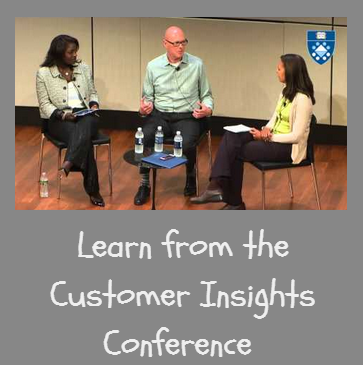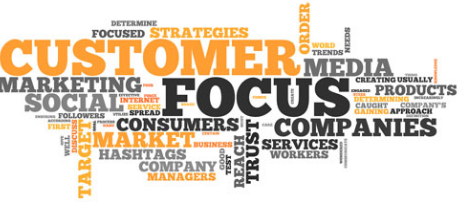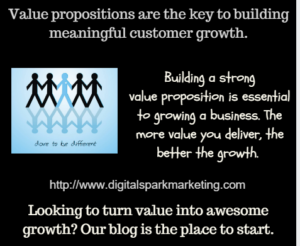Be in touch with your customers and customer data. It is the best way to gain meaningful insights. Do you often attend conferences to network and learn new things?

They can be very valuable on both counts but time-consuming and expensive. We have found that selecting conferences with high priority subjects, and then reading the briefings after the conference can be an acceptable substitute. That is the case in the 2015 Yale Customer Insights Conference.
Check out our thoughts on customer focus.
At the Yale Customer Insights Conference, leading thinkers and doers came together to share notes at an event exploring the frontiers of marketing strategy, consumer choice, and product innovation.
Before we continue, let me ask you a question.
What works best for gathering customer insights in your business? We would love to hear what it was. Would you do us a favor and post it in the comments section below? Be the one who starts a conversation.
With the advent of the Internet, the number of marketing options available to both budding and experienced entrepreneurs has become staggering.
Keep reading and we will share with you the five key topics we learned from our reading, study, and further research from the customer insights conference.:
Customer data … customer control is growing
Call of Duty is a first-person video game franchise. In fact, it is the number 1 gaming channel on all the major social media channels (Facebook, YouTube, etc.is). Its videos have been viewed 500+ million times. The series began on the PC and later expanded to consoles and handhelds. Several spin-off games have also been released.
Customer data examples … the surprising fact
Is that user-generated videos about Call of Duty have been viewed 10 billion + times? Wow, now that is what I would call customer control, how about you? So the community is a big key here and brands need to give up the control.
Customer natural desire for control is a theme that plays continuously in advertising. In 2010 for example, National Car Rental ads showed how customers could register online, avoid the counter and pick any car in the lot. The campaign featured tennis star John McEnroe, famous for his mid-match tantrums, discovering he can select any car he wants and shouting, “Choose any car? You cannot be serious!”
Most car rental companies had already given drivers some control over the rental process by letting them choose the size or request a specific model. But National Car Rental went a step further to let the customer choose any specific car they wanted!
Related material: 10 Extraordinary Ways for Learning to Learn
For businesses, this translates into providing customers with greater control over their purchasing decisions, allowing customers to experience their buying behavior as self-determined and internally motivated.
It gets better:
for example, when the Apple iPod came out, it was a radical innovation in terms of allowing consumers to control what they listened to. Music consumers no longer needed to wade through an entire collection of songs to enjoy the two or three they wanted to hear.
The iPod users were their own DJs, putting together playlists as they skipped from album to album or experiencing a sense of discovery by setting their iPod to “random.” Apple innovators showed a clear insight understanding of people’s deep desire to control their music.
The bottom line
Clearly, putting customer insights to work by giving up control makes good business sense. Several conference reports suggest that more enterprises are realizing that their customers hold the key when given control.

Business collaboration with customers
But giving customers the control is only one of key changes occurring. Businesses are also vastly increasing the amount of partnering with customers.
For example, Call to Duty partnered with 200 YouTube influencers to produce 5000 videos and 360 M views. What an awesome example of business collaboration with customers.
You may be wondering …
about the huge customer experience divide:
81% of businesses say they have a holistic view of customers
While
37% of customers say their favorite retailer understands them
And many challenges remain to keep this the status quo. Among these: data explosion, social media growth, many more channels and devices, and continually shifting demographics.
So for those organizations that haven’t quite got it figured out yet, here are the three awesome examples of making customer collaboration work better:
Make it open
For decades, LEGO was a closed organization, even going so far as to be on the record as saying, “We don’t accept unsolicited ideas.”
But that all changed in 2004 when Jørgen Vig Knudstorp was appointed CEO. At a 2005 user convention, he declared to the attendees, “We think innovation will come from a dialogue with the community.” A new era of customer collaboration and innovation was ushered in.
The bottom line
In 1999, LEGO had 11 user groups. By 2012, that number had swelled to 150 groups dedicated to the LEGO brand.
From 2004 to today, LEGO has seen some of the greatest innovations of their product start with these user groups. In addition to simply being open to new ideas from outside the organization, good customer collaboration encourages real feedback for areas of improvement.
Customer Insights Conference … make them partners
Here is another great example of a business / customer partnership. When launching their 2011 album, The Future is Medieval, the band Kaiser Chiefs turned to customer collaboration and transformed their customers into partners.
First, the band provided fans the chance to create their own Kaiser Chief album. Visitors to their site could download 10 songs of their choice (out of 20 available options) and then design their own cover. And that’s when things got really creative.
Collaborators could then share their personalized version of the album on a customizable website, along with banner ads and posters to promote “their” album. Even better, fans made £1 commission on every album they sold. Wow, now that was a real collaborative business model, yes?
By involving customers in the process of creating and promoting their product, the Kaiser Chiefs had effectively turned their customers into partners of their brand. Fans had a vested interest in making the album a success.
The results
speak for themselves: over 100,000 unique visits in the first 24 hours and an increase of 50,000 followers on Twitter.
Why couldn’t your business do something similar? The fact is any brand can offer their customers a spot at the table to share their thoughts and a reward for participating and collaborating—even if it’s simply public recognition for their part in the process.
These two simple acts create lifetime fans and keep fresh ideas rolling in.
Create a customer-centered process
Remember the suggestion box? In days gone by, that 12” x 12” box was the only “space” businesses made for employee and customer inputs. People are dying to tell you what they think about your brand—good and bad. It is simple enough to give them a space to do it in.
Unfortunately, while tweets and posts are a great way to get quick feedback, they don’t offer the capability of having rich and deeply meaningful conversations with customers.
Another example:
about six years ago, Starbucks was facing a problem. Customers felt that the coffee retail giant wasn’t responding to their feedback. Apparently, two things were happening: feedback wasn’t reaching decision makers and there was no real way to show they were acting on the inputs.
So Starbucks created a space for deeper feedback and collaboration. Now in its sixth + year, MyStarbucksIdea.com is a place for customers to share and discuss ideas, vote for their favorites and interact with Starbucks employees.

The modern customer influencer
Today, we live in a world where influencers often reach audiences through multiple channels. And I’m sure to have noticed that brand experiences come from more than brand touchpoints. Such experiences include celebrity fans, brand authorities, to include friends and content sources. A recent Nielsen reports documents that 92% of consumers trust word of mouth from people, whereas only 47 % of them trust ads from the brands themselves.
Walt Mossberg is a great example of a traditional brand authority. He is a journalist (in his case, at “The Wall Street Journal”), who is amazingly active on blogs (e.g., All Things D, re/code) and is a solid Twitter personality with close to 1M followers.
However, the most important influencers often aren’t journalists, but rather people who are simply taking advantage of multiple channels to reach a wider audience.
For example, Mark Cuban has more than 2.5M Twitter followers and is more influential in both sports and business than most journalists covering these two topics. If he says something interesting about a product or brand, his opinion wields influence.
In today’s interconnected communications landscape, we have to craft a well-reasoned influencer strategy.
And while brand-crafted content is useful and can help build trust with customers, the most influential content comes from like-minded people that your customers know and trust.
Smart companies know that in this new social paradigm, bloggers and others with loyal followers on social media are the new influencers.
The bottom line:
What this means to your business is that there is an existing, powerful arsenal of influence that you can tap into directly. This concept of partnering with bloggers and other active social media users is called “influencer marketing”.
It is based on the premise of finding influencers in your niche to create and distribute relevant content and share it in an authentic and transparent way.
Power of interactive content is key and growing
Which begs the question, what exactly is interactive content?
Most content that we’re familiar with — blog posts, ebooks, reports, webinars, infographics, podcasts, etc. — is designed to be passively consumed by our audiences.
They read, watch, or listen to it. They may comment on it or share it, which is great, but the underlying content doesn’t ask them for input and mostly doesn’t react to them in real time.
In contrast to passive content, interactive content engages an audience as active participants. Interactive content includes quizzes, calculators, configurators, assessment tools, games, contests, workbooks, and more.
You can think of interactive content as lightweight “apps” for the web. Like apps on your smartphone, they offer a useful functionality in a small, easy-to-use digital package.
But unlike smartphone apps, you don’t need to explicitly install them. They’re just embedded into your website, and they work in any modern web browser.
Now:
Why should you use interactive content?
But with interactive content, we can learn a tremendous amount from their interactions — the rankings people give themselves or their companies when taking an assessment, the questions they missed (or nailed) on a topical quiz, the variations they assembled in a product configurator, or the range of parameters they tried with a calculator.
You may be wondering:
What are the interactive techniques to consider:
Interactive Video Marketing
Interactive video marketing differs from “normal static video advertisements” by providing your audience with the choice of interacting with the video instead of simply just watching it. Viewers can interact through physical actions such as touching or clicking.
By inviting your viewer to act, you can effectively boost engagement of your videos. Interactive videos can easily convert leads through a well-timed call to actions.
.
Reveal-Based Marketing
To generate attention today from consumers, marketers must stimulate the receivers’ brain with creative methods.
In essence, humans want to be intrigued, excited, and ultimately blown away.
Here are examples …
of reveal based marketing that you can use are:
Games: Promotions and discounts that require you to scratch away, spin, or play a flash game before viewing a deal.
Problem Solving: Promotions and discounts that require you to draw a picture, build a puzzle, or solve a riddle.
Motion Interactions: Promotions and discounts that require you to move, shake, tilt, blink, or jump to reveal.
With the advance in technology, digital reveal-based marketing has been producing great results. Need proof? According to Adweek, a recent Macy’s “reveal based” banner ad saw “the average person spends more than three minutes interacting with the unit, and the interaction rate was 921 percent”.
Polling
Polling is one of the most effective and simple tools for immediate engagement. A few reasons to use polling are:
Effective audience feedback
By using polls, you can ask your audience for their thoughts in a way that is easy, fast, and fun for them.
Engagement
Polls show your customers that the communication goes both ways, and it invites them to join in on the fun. It is a great technique for listening and shows them you care about their input.
Double the Content
When you add a poll, you’re really adding two pieces of content: The actual poll itself, as well as a piece sharing the results. This way, your audience is interacting with your brand twice – once with the poll through voting, and again with the results through commenting.
Visualization is becoming the new dominant language
Data visualization is the study of the visual representation of data. Simply put, this means information that has been abstracted in some schematic form.
According to Friedman (2008):
The main goal of data visualization is to communicate information clearly and effectively through graphical means. It doesn’t mean that data visualization needs to look boring to be functional or extremely sophisticated to look beautiful. To convey ideas effectively, both aesthetic form and functionality need to go hand in hand, providing insights into a rather sparse and complex data set by communicating its key-aspects in a more intuitive way. Yet designers often fail to achieve a balance between form and function, creating gorgeous data visualizations which fail to serve their main purpose — to communicate information.
An interesting quote …
from Google chief economist, Hal Varian:
The ability to take data – to be able to understand it, to process it, to extract value from it, to visualize it, to communicate it, is going to be a hugely important skill in the next decade.
I could not agree more.
The significance of visual content
Let’s examine the rising trend of visual content marketing and how it ties into the idea that traditional content is falling into the same trap of traditional advertising.
As a content marketer, you’ve naturally realized the importance of visual content. Having an image associated with your blog results in a much higher click rate, and images and videos have a much higher chance of going viral through social media. As a result, most content marketers have integrated visual content–such as infographics and short video demonstrations or testimonials–into their campaigns.
Audiences react to this visual content more significantly because it engages them more. Rather than needing to read several hundred words, they can immerse themselves in the visual medium. It’s more of an experience, and therefore, it gets more attention and more favoritism.
How content marketing will become interactive
In order to identify the next marketing breakthrough, we need to find a strategy that gives users an engaging experience.
Interactive content marketing does this. Because it’s new, it won’t be overwhelming. Because it will be personally customized, it will be trusted. Because it’s personally informative, it’s more valuable than traditional content marketing. And because it’s personally immersive, it’s a more engaging experience.
The bottom line

























